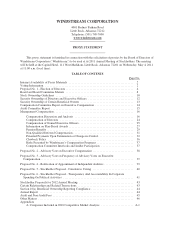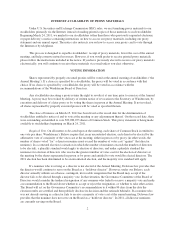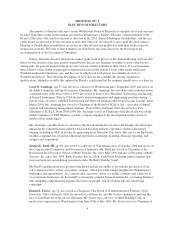Windstream 2010 Annual Report Download - page 16
Download and view the complete annual report
Please find page 16 of the 2010 Windstream annual report below. You can navigate through the pages in the report by either clicking on the pages listed below, or by using the keyword search tool below to find specific information within the annual report.
strong interpersonal and communication skills; demonstrated ability to solve problems and to build consensus
among diverse viewpoints; a commitment to serve on the Board over a period of several years to develop
knowledge about Windstream, its strategy, and its principal operations; a willingness to evaluate management
performance objectively; and the absence of activities or interests that could conflict with the director’s
responsibilities to Windstream. The Governance Committee does not have a formal policy on diversity with
regard to consideration of director nominees, but the Governance Committee considers diversity in its selection
of nominees and seeks to have a board that reflects a diverse range of views, backgrounds and experience.
The Governance Committee will consider director candidates recommended by stockholders. To qualify
for such consideration, stockholder recommendations must be submitted to the Governance Committee in
accordance with the substantive and procedural requirements set forth in Windstream’s Bylaws, as discussed
below under the caption “Other Matters”. The Governance Committee does not have a specific policy regarding
the consideration of stockholder recommendations for director candidates because the Committee intends to
evaluate stockholder recommendations in the same manner as it evaluates director candidates recommended by
other sources.
Management of Windstream has the primary responsibility for managing the risks facing Windstream,
subject to the oversight of the Board of Directors. Each Committee of the Board assists the Board of Directors to
discharge its risk oversight role by performing the subject matter responsibilities outlined above in the
description of each Committee. The Board of Directors retains full oversight responsibility for all subject matters
not assigned to Committees including risks presented by business strategy, competition, regulation, general
industry trends including the disruptive impact of technological change, capital structure and allocation, and
mergers and acquisitions. The Board of Directors supplements its ability to discharge its risk oversight role by
receiving a report on the results of an annual risk assessment of Windstream that is prepared by the Internal
Audit Department. This survey is used primarily to assist the Internal Audit Department to prepare the scope of
its annual audit plan, subject to the review and approval of the Audit Committee. Internal Audit prepares the risk
assessment by conducting risk assessment interviews and surveys with management across the Company to
identify individual process and Company-wide risks. An annual report on the top risks to Windstream identified
by this assessment process is presented to the Audit Committee and the full Board.
Windstream’s Corporate Governance Board Guidelines, its code of ethics policy entitled “Working With
Integrity”, and the charters for the Audit, Compensation and Governance Committees are available on the
Investor Relations page of the Windstream Corporation website at www.windstream.com/investors. Copies of
each of these documents are also available to stockholders who submit a request to Windstream Corporation,
ATTN: Investor Relations, 4001 Rodney Parham Road, Little Rock, AR 72212. Stockholders and other interested
parties may contact the Chairman of the Board or the non-management directors of the Windstream Board of
Directors by writing to Windstream Corporation, ATTN: Chairman of the Board or Non-Management Directors,
c/o Corporate Secretary, 4001 Rodney Parham Road, Little Rock, AR 72212.
STOCK OWNERSHIP GUIDELINES
The Windstream Board of Directors has adopted minimum stock ownership guidelines for Windstream’s
directors and executive officers. Directors who are not executive officers are expected to maintain beneficial
ownership of shares of Windstream Common Stock valued at least five times the annual cash retainer paid to
non-management directors. Executive officers are expected to maintain beneficial ownership of shares of
Common Stock at the following levels: ten times base salary for the Chief Executive Officer; five times base
salary for each of the Chief Financial Officer, Chief Operating Officer and General Counsel; and three times base
salary for all other executive officers. Directors have a transition period of five years from their initial election
(or, for incumbent directors as of November 2006, until the date of the 2011 Annual Meeting of Stockholders),
and executive officers have a transition period of three years from their initial election to meet the applicable
ownership guidelines and, thereafter, one year to meet any increased ownership requirements resulting from
10
























